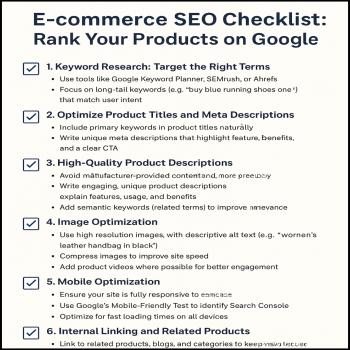
Posted on: 2 days ago
E-commerce SEO Checklist: Rank Your Products on Google
#DigitalMarketing, EcommerceGrowth, EcommerceSEO, GoogleRanking, IncreaseSalesOnline, KeywordOptimization, OnlineBusiness, OnlineStoreTips, ProductMarketing, ProductSEO, SEOChecklist, SEOForEcommerce, SEOForProducts, SEOStrategy, WebsiteOptimization
3 | 0 | 0
In today’s competitive online marketplace, simply listing your products on an e-commerce website is not enough. With thousands of similar products available, your store must stand out in search engine results to drive organic traffic and sales. That’s where E-commerce SEO comes in. A well-structured SEO strategy ensures that your products appear when potential buyers search on Google, increasing visibility, clicks, and conversions.
Below is a comprehensive e-commerce SEO checklist to help your store rank higher and attract the right customers.
1. Keyword Research: Target the Right Terms
- Use tools like Google Keyword Planner, SEMrush, or Ahrefs to find product-specific keywords.
- Focus on long-tail keywords (e.g., “buy blue running shoes online”) that match user intent.
- Analyze competitors’ keywords and identify gaps you can fill.
2. Optimize Product Titles and Meta Descriptions
- Include primary keywords in product titles naturally.
- Write unique meta descriptions that highlight features, benefits, and a clear CTA (Call-to-Action).
- Keep titles under 60 characters and descriptions under 160 for best results.
3. High-Quality Product Descriptions
- Avoid using manufacturer-provided content; Google may treat it as duplicate.
- Write engaging, unique product descriptions that explain features, usage, and benefits.
- Add semantic keywords (related terms) to improve relevance.
4. Image Optimization
- Use high-resolution images with descriptive alt text (e.g., “women’s leather handbag in black”).
- Compress images to improve site speed.
- Add product videos where possible for better engagement.
5. Site Structure and Navigation
- Keep your site user-friendly with clear product categories.
- Use breadcrumb navigation to help both users and search engines.
- Maintain clean, keyword-rich URLs (e.g., example.com/mens/shoes/running-shoes).
6. Mobile Optimization
- Ensure your site is fully responsive; most online shopping happens via mobile.
- Use Google’s Mobile-Friendly Test to identify issues.
- Optimize for fast loading times on all devices.
7. Technical SEO Essentials
- Submit an updated XML sitemap to Google Search Console.
- Fix broken links, duplicate content, and crawl errors.
- Implement HTTPS for secure browsing and better ranking signals.
- Use structured data (schema markup) to show rich snippets like price, ratings, and availability.
8. Internal Linking and Related Products
- Link to related products, blogs, and categories to keep visitors exploring your site.
- Use keyword-rich anchor text for internal links.
- Build a strong interlinking strategy to distribute ranking power across pages.
9. Customer Reviews and Ratings
- Encourage buyers to leave reviews; it builds trust and improves SEO.
- Display star ratings and testimonials on product pages.
- Respond to reviews for better customer engagement.
10. Content Marketing for E-commerce
- Publish blogs, buying guides, and how-to articles around your products.
- Share content on social media to attract backlinks.
- Use influencer collaborations to increase reach and credibility.
11. Monitor and Measure Performance
- Track rankings, traffic, and conversions using Google Analytics and Search Console.
- Identify top-performing products and replicate strategies for others.
- Continuously optimize based on data insights.
Final Thoughts
Ranking your products on Google takes consistent effort, but the payoff is huge: more visibility, more clicks, and more sales. By following this E-commerce SEO checklist, you’ll not only improve search rankings but also create a seamless shopping experience for your customers.
Welcome to CodePits.
CodePits provide a collection of tutorials about many programming languages like PHP, Laravel Framework, Codeigniter Framework, Mysql Database, Bootstrap Front-end Framework, Jquery, Node JS, Ajax Example, APIs, CURL Example, Composer Packages Example, AngularJS, Ionic Framework, etc. 🙌
Other Posts
Categories
Tags
Comment
 PR
PR Home
Home Demos
Demos Near By
Near By
Comments (0)
🤔
No comments yet, be the first to help
load more